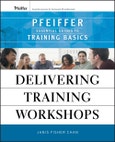PFEIFFER ESSENTIAL GUIDES TO TRAINING BASICS
Delivering Training Workshops is filled with practical information, best practices, and proven strategies. This book will help trainers, no matter what their level of experience, prepare and deliver effective workshops that achieve results for both individuals and their organizations while meeting the challenges of today's fast-paced, rapidly changing learning environment. It covers a wide range of topics, including:
- Planning and scheduling a workshop
- Methods for preparing workshop participants to learn
- Tips to help trainers increase their confidence
- Keep participants engaged and involved
- How to present information clearly, respond to questions, and manage the group
- Tools for measuring workshop success
- Methods for conducting virtual workshops
The Pfeiffer Essential Guides to Training Basics is a three-volume seriesTraining Fundamentals, Designing and Developing Training Programs, and Delivering Training Workshopsthat offers new and experienced trainers a wealth of ideas, information, tips, tools, and techniques.
Praise for Delivering Training Workshops
"Here's a terrific guide....to make sure you successfully teach others what you know."
Barbara Nelson, principal of Nelson Communications
"Janis Chan guides you step-by-step through the process of planning and delivering training that engages participants and helps them learn, sharing her vast store of practical tips and techniques."
Sue Funkhouser, facilitator and organization development consultant, Pinwheel Performance
"A learning tool....to increase your confidence and deliver training that achieves results."
Natasha Terk, President, Write It Well
Table of Contents
INTRODUCTION.1. PREPARING FOR A WORKSHOP.
1. The Importance of Preparation.
2. What's Involved in Preparation.
3. What to Consider When Preparing for a Workshop.
What's Next?
2. SCHEDULING THE WORKSHOP AND PLANNING THE LEARNING ENVIRONMENT.
1. What to Consider When Scheduling.
2. Planning the Learning Environment.
What's Next?
3. PREPARING PARTICIPANTS TO LEARN.
1. How Participants Are Selected.
2. Using Pre-Work Assignments to Engage and Prepare Participants.
3. Getting Managers' Support.
What's Next?
4. PREPARING MATERIALS AND SUPPLIES.
1. What to Consider About Materials and Supplies.
2. Why and How to Use a Checklist.
3. Guidelines for Preparing Materials and Supplies.
4. Make a Backup Plan.
What's Next?
5. PREPARING YOURSELF.
1. A Personal Preparation Primer.
2. Getting to Know the Workshop.
3. Learning More About the Subject.
4. Learning More About the Audience.
5. Thinking About Your Appearance.
6. Practicing Your Delivery.
What's Next?
PART TWO. DELIVERING THE WORKSHOP.
6. GETTING STARTED.
1. Getting Off on the Right Foot.
2. What to Do Before Participants Arrive.
3. Greet People and Make Them Feel Welcome.
4. Opening the Workshop.
What's Next?
7. DELIVERY SKILLS.
1. Overcoming Anxiety and Nervousness.
2. Understanding Nonverbal Communication.
3. Speaking So You Can Be Heard and Understood.
4. Using Equipment, Visual Aids, and Media.
What's Next?
8. HELPING PEOPLE LEARN.
1. Create a Positive Learning Environment.
2. Using Questions.
3. Monitor and Support Individual and Small-Group Work.
What's Next?
9. MANAGING THE LEARNING GROUP.
1. Common Challenges.
2. How to Keep Things Moving and On Track.
3. How to Encourage Participation.
4. How to Handle Behavior Challenges.
What's Next?
10. HOW TO CLOSE AND EVALUATE A WORKSHOP.
1. Why a Closing Is Important.
2. Evaluating the Workshop.
What's Next?
Resources.
About the Author.
Executive Summary
Building on the guidelines laid out in Training Fundamentals and Designing and Developing Training Programs, this book gives detailed guidelines and tools to help trainers prepare for and deliver training workshops often the most daunting phase for new trainers. Specifically, this book:- Shows how to schedule the workshop and how to arrange for the room and equipment.
- Provides logistical guidelines, such as notifying participants, introducing the program, letting people know what to expect and what they will be expected to do and how to prepare materials.
- Offers guidelines for preparing yourself -- the importance of practice; techniques for practice.
- Shows how to get started how to engage participants in the subject right away; establish rapport; address concerns; answering whats in it for me; clarifying objectives and agenda; establishing ground rules, etc.
- Provides presentation skills best practices, covering slides, flip charts, video and provided guidance for using notes and scripts, using gestures, using humor, projecting confidence and enthusiasm, overcoming nervousness, etc.
- Shows how to create a positive, active learning environment, covering helping participants feel comfortable making mistakes, taking risks, speaking up, and working together; reducing interruptions and distractions; asking good questions; giving feedback; keeping things moving.
- Provides guidance for managing the group and facilitating discussions and activities and handling challenging participants.
- Offers guidelines for closing a workshop -- reviewing key content; making commitments and action plans; focusing on next steps.
- Shows how to follow-up after a workshop and steps to reinforce training and build on what was learned.
- Offers sidebars that present nice-to-know information, such as how to deal with resistance from audiences and/or management; what to do when theres too much content for the available time; coping with unrealistic expectations and challenging physical environment, and many more.








